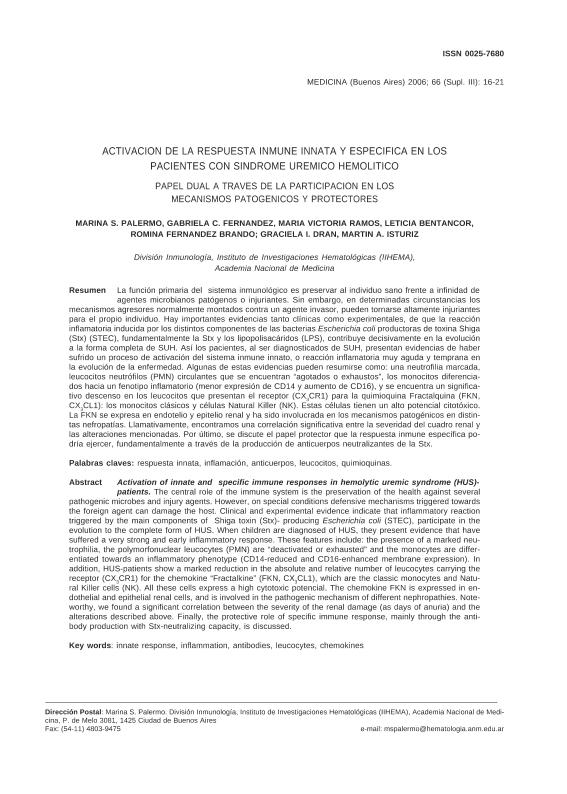Artículo
La función primaria del sistema inmunológico es preservar al individuo sano frente a infinidad de agentes microbianos patógenos o injuriantes. Sin embargo, en determinadas circunstancias los mecanismos agresores normalmente montados contra un agente invasor, pueden tornarse altamente injuriantes para el propio individuo. Hay importantes evidencias tanto clínicas como experimentales, de que la reacción inflamatoria inducida por los distintos componentes de las bacterias Escherichia coli productoras de toxina Shiga (Stx) (STEC), fundamentalmente la Stx y los lipopolisacáridos (LPS), contribuye decisivamente en la evolución a la forma completa de SUH Así los pacientes al ser diagnosticados de SUH, presentan evidencias de haber sufrido un proceso de activación del sistema inmune innato, o reacción inflamatoria muy aguda y temprana en la evolución de la enfermedad. Algunas de estas evidencias pueden resumirse como: una neutrofilia marcada, leucocitos neutrófilos (PMN) circulantes que se encuentran “agotados o exhaustos”, los monocitos diferenciados hacia un fenotipo inflamatorio (menor expresión de CD14 y aumento de CD16), y se encuentra un significativo descenso en los leucocitos que presentan el receptor para la quimioquina Fractalquina (FKN, CX3CL1)) (CX3CR1): los. monocitos clásicos y células Natural Killer (NK). Estas células tienen un alto potencial citotóxico. La FKN se expresa en endotelio y epitelio renal y ha sido involucrada en los mecanismos patogénicos en distintas nefropatías. Llamativamente, encontramos una correlación significativa entre la severidad del cuadro renal y las alteraciones mencionadas. Por último se discute el papel protector que la respuesta inmune específica podría ejercer, fundamentalmente a través de la producción de anticuerpos neutralizantes de la Stx. The central role of the immune system is the preservation of the health against several pathogenic microbes and injury agents. However, on special conditions defensive mechanisms triggered towards the foreign agent can damage the host. Clinical and experimental evidence indicate that inflammatory reaction triggered by the main components of Shiga toxin (Stx)- producing Escherichia coli (STEC), participate in the evolution to the complete form of HUS. When children are diagnosed of HUS, they present evidence that have suffered a very strong and early inflammatory response. These features include: the presence of a marked neutrophilia, the polymorfonuclear leucocytes (PMN) are “deactivated or exhausted” and the monocytes are differentiated towards an inflammatory phenotype (CD14-reduced and CD16-enhanced membrane expression). In addition, HUS-patients show a marked reduction in the absolute and relative number of leucocytes carrying the receptor (CX3CR1) for the chemokine “Fractalkine” (FKN, CX3 CL1), which are the classic monocytes and Natural Killer cells (NK). All these cells express a high cytotoxic potencial. The chemokine FKN is expressed in endothelial and epithelial renal cells, and is involved in the pathogenic mechanism of different nephropathies. Noteworthy, we found a significant correlation between the severity of the renal damage (as days of anuria) and the alterations described above. Finally, the protective role of specific immune response, mainly through the antibody production with Stx-neutralizing capacity, is discussed.
Activación de la respuesta inmune innata y específica en los pacientes con Síndrome Urémico Hemolítico: Papel dual a través de la participación en los mecanismos patogénicos y protectores
Título:
Activation of innate and specific immune responses in hemolytic uremic syndrome (HUS)- patients
Palermo, Marina Sandra ; Fernandez, Gabriela C.; Ramos, Maria Victoria; Bentancor, Leticia; Fernández Brando, Romina Jimena
; Fernandez, Gabriela C.; Ramos, Maria Victoria; Bentancor, Leticia; Fernández Brando, Romina Jimena ; Dran, Graciela I.; Isturiz, Martín Amadeo
; Dran, Graciela I.; Isturiz, Martín Amadeo
 ; Fernandez, Gabriela C.; Ramos, Maria Victoria; Bentancor, Leticia; Fernández Brando, Romina Jimena
; Fernandez, Gabriela C.; Ramos, Maria Victoria; Bentancor, Leticia; Fernández Brando, Romina Jimena ; Dran, Graciela I.; Isturiz, Martín Amadeo
; Dran, Graciela I.; Isturiz, Martín Amadeo
Fecha de publicación:
12/2006
Editorial:
Medicina (Buenos Aires)
Revista:
Medicina (Buenos Aires)
ISSN:
0025-7680
e-ISSN:
1669-9106
Idioma:
Español
Tipo de recurso:
Artículo publicado
Clasificación temática:
Resumen
Archivos asociados
Licencia
Identificadores
Colecciones
Articulos(IMEX)
Articulos de INST.DE MEDICINA EXPERIMENTAL
Articulos de INST.DE MEDICINA EXPERIMENTAL
Citación
Palermo, Marina Sandra; Fernandez, Gabriela C.; Ramos, Maria Victoria; Bentancor, Leticia; Fernández Brando, Romina Jimena; et al.; Activación de la respuesta inmune innata y específica en los pacientes con Síndrome Urémico Hemolítico: Papel dual a través de la participación en los mecanismos patogénicos y protectores; Medicina (Buenos Aires); Medicina (Buenos Aires); 66; Supl. III; 12-2006; 16-21
Compartir



